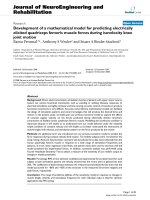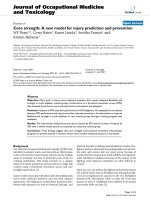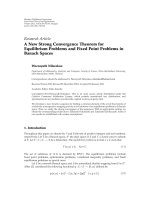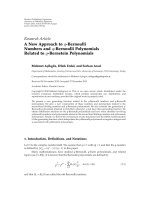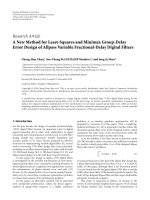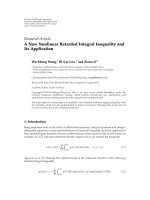Báo cáo hóa học: "Core strength: A new model for injury prediction and prevention" pptx
Bạn đang xem bản rút gọn của tài liệu. Xem và tải ngay bản đầy đủ của tài liệu tại đây (292.25 KB, 9 trang )
BioMed Central
Page 1 of 9
(page number not for citation purposes)
Journal of Occupational Medicine
and Toxicology
Open Access
Research
Core strength: A new model for injury prediction and prevention
WF Peate*
1
, Gerry Bates
2
, Karen Lunda
3
, Smitha Francis
1
and
Kristen Bellamy
1
Address:
1
University of Arizona, Mel and Enid Zuckerman Arizona College of Public Health, Drachman Hall, 1295 N. Martin Avenue, Tucson,
Arizona, USA,
2
Tucson Fire Department, Health and Safety, 421 South Church, Tucson, Arizona, USA and
3
Lunda and Associates, 1636 North
Swan, Tucson, Arizona, USA
Email: WF Peate* - ; Gerry Bates - ; Karen Lunda - ;
Smitha Francis - ; Kristen Bellamy -
* Corresponding author
Abstract
Objective: Many work in injury prone awkward positions that require adequate flexibility and
strength in trunk stabilizer muscle groups. Performance on a functional movement screen (FMS)
that assessed those factors was conducted and an intervention was designed.
Methods: A battery of FMS tests were performed on 433 firefighters. We analyzed the correlation
between FMS performance and injuries and other selected parameters. An intervention to improve
flexibility and strength in trunk stabilizer or core muscle groups through a training program was
evaluated.
Results: The intervention reduced lost time due to injuries by 62% and the number of injuries by
42% over a twelve month period as compared to a historical control group.
Conclusion: These findings suggest that core strength and functional movement enhancement
programs to prevent injuries in workers whose work involves awkward positions is warranted.
Background
The National Occupational Research Agenda (NORA) has
identified traumatic injury and intervention effectiveness
as two of its priority research areas. Injuries are the leading
cause of mortality and loss of potential years of life for
working individuals. This study focused on a unique
method of injury prediction and prevention in high risk
workers using a functional movement screen and core
strength intervention [1].
Many workers must deal with physically demanding tasks
that involve awkward positions and less than optimal
ergonomics. Fire fighting is a particularly hazardous pro-
fession with exposure to a host of chemical, biologic, and
physical hazards including musculoskeletal trauma. Fire-
fighters perform physically demanding tasks such as forci-
ble entry and rescues that are injury prone because of
maneuvers that compromise trunk stability and ergonom-
ically hazardous conditions Because of the nature of fire
fighting, these physical conditions are often difficult to
control.
There are over one million fire fighters in the United States
[2]. and the injury rates of firefighters are among the high-
est in all occupations [3]. Last year in the U.S. firefighters
sustained 88, 500 injuries while on duty [4]. Forty four
percent of all U.S. firefighters have suffered from sprains
and strains while on duty [5].
Published: 11 April 2007
Journal of Occupational Medicine and Toxicology 2007, 2:3 doi:10.1186/1745-6673-2-3
Received: 21 May 2006
Accepted: 11 April 2007
This article is available from: />© 2007 Peate et al; licensee BioMed Central Ltd.
This is an Open Access article distributed under the terms of the Creative Commons Attribution License ( />),
which permits unrestricted use, distribution, and reproduction in any medium, provided the original work is properly cited.
Journal of Occupational Medicine and Toxicology 2007, 2:3 />Page 2 of 9
(page number not for citation purposes)
It is important for firefighters to be fit because they work
in physically unpredictable settings, and must maintain a
high level of fitness for at least 20 years before they are eli-
gible for retirement. Various strategies have been evalu-
ated to decrease the occurrence and the severity of fire
fighter injuries. These methods have focused on exercise
training, ergonomic coaching and flexibility improve-
ments [6]. A physical fitness intervention for firefighters
was shown to be effective in reducing injuries, but the
scope of the study was limited to back disorders [7]. A fire-
fighter flexibility training program did not find improve-
ment in injury incidence, though lost time, severity and
costs improved [8]. Workplace injuries are multi-factorial,
especially in occupations where work events are unpre-
dictable and task completion places rigorous demands on
the body. Furthermore, many ergonomic interventions
have limited applicability in certain firefighter tasks. For
example, a firefighter who must crawl under wreckage and
contort his or her body to rapidly rescue a trapped indi-
vidual has severe ergonomic challenges that are difficult
to address with standard ergonomic suggestions such as
"lift with your legs, not your back." Although many fire-
fighter exercise programs have focused on upper and
lower body strength, they have paid less attention to core
stability and strength (provided by spine stabilizers such
as the transversus and multifidi muscles) and the other
dimensions of movement that might decrease the chance
of injury in the above scenario [9]. As Wilson et al summa-
rize: "Core stability is the ability of the lumbopelvic hip
complex to prevent buckling and to return to equilibrium
after perturbation. Although static elements (bone and
soft tissue) contribute to some degree, core stability is pre-
dominantly maintained by the dynamic function of mus-
cular elements. There is a clear relationship between trunk
muscle activity and lower extremity movement" [10].
Current research suggests that decreased core strength may
contribute to injuries of the back and extremities, that
training may decrease musculoskeletal damage, and that
core stability can be tested using functional movement
methods [11-13].
The purpose of this study was to explore methods to better
assess the risk of firefighter injury due to functional move-
ment performance, and to decrease injuries by using that
information. The magnitude of injuries among firefighters
warrant efforts to develop and assess the effectiveness of
interventions. One approach has been to examine the
relationship between simulated firefighting tasks and
physical performance or functional measures [14].
Researchers have demonstrated that activities such as stair
climbing ability are related to certain functional measures
such as standing balance, reaction time, isometric muscle
strength [15].
Furthermore, improvements in core or static strength,
flexibility and the three dimensions of movement: accel-
eration; deceleration; and dynamic stabilization (the abil-
ity to maintain a stable posture while moving) have been
proposed as additional injury prevention possibilities for
fire fighters [16].
Our research objective was to determine whether results
of measurement of functional movement were associated
with a history of previous work-related injuries in this
high risk population and to conduct an intervention.
Functional movement screens were initially used to eval-
uate and rehabilitate patients with neuromuscular coordi-
nation issues, such as those with stroke or spinal trauma
[17,18]. More recently, functional movement screens
have been employed to assess the movement patterns of
athletes. Those with a lower performance score have been
found to be more likely to sustain an injury [19].
We used the functional movement screen (FMS) for fire
fighters because their job tasks often require maximal
physical performance, [20] thus making them "industrial"
athletes. The relation between the FMS score and age,
rank, tenure and gender was also assessed. If a correlation
existed between functional movement screen perform-
ance and injuries, then appropriate interventions such as
flexibility and core strength training could be initiated to
decrease fire fighter injury rates. A second arm of the study
involved a twelve month prospective analysis of such an
intervention.
The functional movement screen consists of seven differ-
ent functional movements that assess: trunk or core
strength and stability; neuromuscular coordination; sym-
metry of movement; flexibility; acceleration; deceleration;
and dynamic stability. Each of these seven movements
corresponds to a firefighter activity. For example, one of
the FMS measures is the rotatory stability test. This test
requires the firefighter to maintain spinal column stability
with upper and lower trunk motion while balancing their
weight with one hand and knee on the floor. The maneu-
ver duplicates the fire fighter work practice of staying low
to the floor while entering a burning building (Heat rises.
Standing subjects the fire fighter to higher thermal
energy.). The other FMS tests and their correspondence to
fire fighter essential functions include:
Hurdle step: body mechanics while stepping over an
obstacle during a fire or rescue.
In-lunge movement: ability to take one long step forward
and lunge downward, such a while using an axe to open a
door during a fire.
Journal of Occupational Medicine and Toxicology 2007, 2:3 />Page 3 of 9
(page number not for citation purposes)
Shoulder mobility: firefighter lifting and placing a SCBA
(self contained breathing apparatus) respirator on their
back.
Stability push-ups (press-ups):core strength while reach-
ing through or around an obstruction during a fire or res-
cue.
Deep squat: ability to squat to avoid an overhead hazard
during a fire or rescue.
Active straight leg raise: flexibility of the lumbar-pelvic
complex and lower extremity muscles. Maintenance of
torso and pelvic stability during awkward positions at a
fire or rescue operation.
Methods
Subjects
Environment Occupational Health (EOH) Unit faculty of
the University of Arizona were awarded a contract to pro-
vide medical surveillance, and injury prevention and
treatment for Tucson Fire Department, an urban fire fight-
ing agency in a community of 765, 000. All 433 subjects
were involved in fire suppression activities and were on a
full duty status. Age at time of the study ranged from 21 to
60 years with a mean of 41.8 years for males and 37.4
years for females. The subjects were 408 male (94.2 per-
cent) and 25 female (5.8 percent).
Demonstration of the FMS tests was conducted by a
trained fitness coordinator. Informed consent was pro-
vided by a fire department representative.
Scores on the seven FMS tests were based on the fire-
fighter's ability to perform the respective test. Zero to three
points were possible for each of the seven tests (Total of
21 points). The maximum number of points was given if
the individual could fully perform the test without limita-
tion of movement or pain. Lesser points were given for
partial completion of the test and no points for failure to
complete any elements of the test.
The battery of FMS tests were performed on 433 firefight-
ers over a four week period in late 2004. We analyzed the
correlation between FMS performance and a history of
prior musculoskeletal injury from the fire department
database, and other selected parameters (age, gender, ten-
ure and rank).
One firefighter sustained a minor strain during the testing
process, and fully recovered one week later and was
returned to full duty.
The firefighters were then enrolled in a training program
designed by a multi-disciplinary team (occupational med-
icine physician, therapist, and fire department health and
safety officer). Twenty one seminars, each three hours in
length were conducted for groups of 20 firefighters over a
two month period. Each session emphasized functional
movement including the causation (inadequate core or
back stabilizing muscle strength, poor flexibility, and
improper body mechanics) and prevention of injuries. As
part of the training session, each firefighter then demon-
strated competency in the proper body mechanics in sam-
ple firefighter work settings. Firefighters are compelled to
work in injury prone situations such as bending forward
at the waist and reaching through the broken window of
a wrecked automobile while assessing a victim. In this sce-
nario core stabilizing muscles become fatigued and are at
risk of injury. Participants were taught techniques to
strengthen core muscles and to decrease mechanical load
on the affected parts of their musculoskeletal system dur-
ing these ergonomically challenging job tasks. For exam-
ple, firefighters were instructed to use an outstretched arm
held against a firm surface as a prop to decrease mechani-
cal load on the back when the firefighter's spine is in lum-
bar flexion. Firefighters were instructed how to analyze
the worksite and to use principles of functional move-
ment (how to adjust to the employee's range of motion by
moving closer to object to be lifted, to use postural relief
or props, and "tighten the gut" or recruit stabilizing mus-
cle before lifting). During each session, guidance and
practice on core or stabilizing muscle strength exercises
were offered. Demonstration of the exercises was pro-
vided by a trained co-worker. Core strength instructions
were provided to each participant. They were advised to
maintain a neutral position of the lumbar spine and to
contract the transversus abdominus (TA) muscle. Partici-
pants were shown that muscle's location in the anterior
abdominal wall. Photos of various methods of recruiting
and strengthening the TA with written explanations were
provided, along with verbal reinforcement of the material.
Once the firefighter demonstrated competency in basic TA
muscle tightening, physiotherapy balls and dowels were
employed to challenge the firefighter in different posi-
tions that mimicked firefighting tasks. See Figure 1
- Lie on your back, knees bent, feet flat on the floor.
- Tighten the gut to maintain a neutral position of the low
back (no arching or flattening)
- Lift up butt. Knees, hips and shoulders should all be in a
line.
- If the butt starts sagging, lift it back up. If the hamstrings
cramp, take a break and begin again.
- Add arm movement, one or both with or without
weight/resistance
Journal of Occupational Medicine and Toxicology 2007, 2:3 />Page 4 of 9
(page number not for citation purposes)
- Keep the butt up and the gut tight throughout the exer-
cise.
- 5–10 reps, 1–3 sets of each variation of the exercise.
- Progress to a one legged bridge.
- Assume position above, lift the right foot up off of the
floor.
- Extend knee out away from you (straighten the knee)
and then bring it back toward you.
- Repeat the bending and straightening of the knee/leg
- The straighter and lower the leg, the harder the exercise.
- Keep the butt up and the gut tight throughout the exer-
cise.
- Repeat with left leg off the floor.
- Add arm movement to leg movement and then add
weights/resistance.
- 5–10 repetitions, 1–3 sets of each variation of the exer-
cise.
See Figure 2.
- Correct physio-ball size equals a 90 degree knee bend
when sitting on the ball. If greater than 90, inflate the ball.
This does not need to be exact.
- Assume the starting position with shoulders on the ball,
feet on the floor, knees bent to 90.
- The more of the back that is on the ball, the more stable,
the easier the exercise.
- Shoulders, hips and knees in a line
- Tighten the gut
- Add arm movement, one or both with or without
weights/resistance
- Do not let the back arch or flatten.
Bridging with shoulders on a ballFigure 2
Bridging with shoulders on a ball.
Keeping the transversus abdominus contracted and using the upper and lower extremitiesFigure 1
Keeping the transversus abdominus contracted and using the
upper and lower extremities.
Journal of Occupational Medicine and Toxicology 2007, 2:3 />Page 5 of 9
(page number not for citation purposes)
- To increase the difficulty, add a small object between the
knees and squeeze or add a band around the knees and
push the knees apart
- Keep the gut tight and the butt up
- To further increase the difficulty, roll further off of the
ball so only the shoulders are on the ball.
- Perform 5 – 10 repetitions, 1 – 3 sets of each variation of
the exercise
Figure 3
- Correct physio-ball size equals a 90 degree knee bend
when sitting on the ball. If greater than 90, inflate the ball.
This does not need to be exact.
- Lye on your back, knees bent, soles of feet on the ball.
- Tighten your gut to maintain a neutral lumbar spine (no
arching or flattening)
- Lift up your butt.
- If your butt starts sagging, lift it back up. If you can't, the
set is over.
- If the hamstrings cramp, take a break and begin again.
- Arms may need to provide support/stability on the
ground initially.
- Once stable, add arm movement, one or both with or
without weight/resistance
- Keep the butt up and the gut tight.
- The further the arms go overhead, the more the back
wants to arch.
- Prevent the arch by keeping the gut tight.
- If the back continues to arch, decrease the amount of arm
movement or decrease the weight/resistance until you can
maintain a neutral spine (no arching or flattening of the
back).
- 5–10 reps, 1–3 sets of each variation of the exercise
For one year following training, information on the type
and number of injury cases, cost of treatment, and lost
days due to injury were gathered by the organization's
worker's compensation department. The data was derived
from personnel, absentee and medical records for a one-
year period.
Statistical Analyses
Part One. Functional Movement Screen
Data was coded using Stata 8.0. For exploratory data anal-
ysis we used bivariate methods. The primary hypothesis
was assessed with multivariate analysis (logistic and linear
regression). Table 1 provides functional movement screen
summary descriptive statistics by overall score
Part Two: Intervention
All injury cases were reviewed for the year before this
study and the year following. ICD 9 codes were tabulated
and all injury cases underwent medical review. Injuries
not related to functional movement such as burns, abra-
sions, and lacerations were excluded from the analysis. A
historical control group was formulated and compared
with the intervention population.
Results
Part One. Functional Movement Screen
Based on simple linear regression, increasing age, rank
and tenure were associated with a lower functional move-
ment score. Each yearly increase in age resulted in a 0.1
unit decrease in overall score (p < 0.001). After adjusting
for age in multiple linear regression, firefighters with a his-
tory of prior injury scored 0.24 points lower than those
without history of prior injury, though this difference was
not statistically significant (p = 0.25). The outcome varia-
ble was dichotomized to pass (FMS score >16) and fail
(FMS score <16). Multiple logistic regression suggested
that after adjusting for participant age, the odds of failing
the functional movement screen were 1.68 (% confidence
interval: 1.04, 2.71) times greater for firefighters with a
history of any injury (p = 0.033).
Bridging with feet on the ballFigure 3
Bridging with feet on the ball.
Journal of Occupational Medicine and Toxicology 2007, 2:3 />Page 6 of 9
(page number not for citation purposes)
Part Two. Intervention
To test if the percent change in injuries before and after
intervention was significant, a two-sample test of propor-
tions was calculated. This test assumes under the null
hypothesis that the probability of injury pre- and post-
intervention are equal.
Comparing the number of injuries pre- and post-interven-
tion of these 433 firefighters, lost time injuries were
reduced by 62%, whereas total injuries were reduced by
44% compared to a historical control group. The two-
sample test of proportions indicated that significant
reductions were made among injuries of the back (p =
0.024) and upper extremities (p = 0.0303), however, no
significant change was found for injuries of the lower
extremities (p = 0.4624). Similar conclusions were
reached with lost time injuries – significant reductions in
both injuries to the back (p = 0.0036) and upper extremi-
ties (p = 0.0141). Results can be seen in Table 2.
Discussion
Based on linear regression, there is a correlation between
past musculoskeletal injury and FMS score. A history of an
Table 1: Summary Descriptive Statistics by Overall Score
Score Pass Fail
17 <17
Count 300 133
Percent 69.30% 30.70%
Age (yrs)
Mean 39.7 45.7
Median 40 46
S. Deviation 8.3 8.3
Min 23 24
Max 60 61 Z = -6.37, p < 0.001
Score
Mean 18.4 14.7
Median 18 15
S. Deviation 1.1 1.6
Min 17 7
Max 21 16 Z = -16.81, p < 0.001
Injured:
Yes 75 (25%) 43(32%)
No 225 (75%) 90(68%) Chi2 = 2.5, p < 0.114
# Injuries:
Mean 0.37 0.52
Median 0 0
S. Deviation 0.75 0.99
Min 0 0
Max 4 7 Z = -1.6, p < 0.11
Injured & Lost Work Time
Yes 32 (11%) 22 (17%) Chi2 = 2.9, p < 0.09
No 268 (89%) 111 (83%)
Rank (yrs):
Mean 7.6 11.4
Median 5 10
S. Deviation 6.6 7.8
Min 0 0
Max 32 31 Z = -4.7, p < 0.001
Tenure (yrs)
Mean 12.9 18.2
Median 11 19
S. Deviation 8.3 9.4
Min 1 1
Max 35 40 Z = -5.5, p < 0.001
Journal of Occupational Medicine and Toxicology 2007, 2:3 />Page 7 of 9
(page number not for citation purposes)
injury lowered the fire fighter FMS score by 3.44 (maxi-
mum of 21 points). See Table 3.
Based on logistic regression, there is no significant correla-
tion between injuries and FMS score. However, there was
a significant correlation between age, rank, and tenure
and FMS score as noted in Table 4.
NIOSH (the U.S. National Institute for Occupational
Safety and Health) has advised that occupational screen-
ing programs are a priority research area. The U.S. Preven-
tive Services Task Force has recommended specific
guidelines to decide if a screening test such as FMS is effec-
tive, and whether it will improve clinical outcomes [21].
For fire fighters, an important screening component is
essential are fire fighters fit enough to safely perform the
demanding physical tasks of their occupation without risk
of injury?
To what degree did prior injuries hamper the subjects'
ability to perform the functional movement screen tests?
If a firefighter had residual physical limits from a past
injury would it be logical to assume their performance
would be diminished on our testing. Fortunately, all 433
firefighters complete a rigorous annual physical examina-
tion where such limitations would be noted. In addition
all firefighters after an injury must be cleared to return to
full unrestricted duties by the fire department occupa-
Table 3: Linear Regression
Simple Linear Regression
Outcome = (Overall Score - 21)
Model Variable Coeff P > |Z| 95% CI R-square
1 Constant 3.78 0.001 (3.57, 3.99)
Female -0.74 0.093 (-1.60, 0.13) 0.007
2 Constant -0.36 0.427 (-1.26, 0.54)
Age 0.099 0.001 (0.08, 0.12) 0.163
3 Constant 2.938 0.001 (2.64, 3.24)
Rank 0.091 0.001 (0.06, 0.12) 0.053
4 Constant 2.54 0.001 (2.18, 2.90)
Tenure 0.08 0.001 (0.06, 0.10) 0.120
5 Constant 2.6 0.001 (2.46, 2.75)
Any Injuries 3.69 0.001 (3.43, 3.95) 0.638
6 Constant 3.69 0.001 (3.46, 3.91)
# Injuries 0.12 0.328 (-0.12, 0.36) 0.002
7 Constant 3.7 0.001 (3.49, 3.92)
Injured & Lost Time 0.28 0.368 (-0.33, 0.89) 0.002
Multiple Linear Regression
Outcome = (Overall Score - 21)
Final Model Only
Model Variable Coeff P > |Z| 95% CI R-square Adjusted
1 Constant 0.99 0.001 (0.41, 1.57)
Age 0.04 0.001 (0.03, 0.05)
Any Injuries 3.44 0.001 (3.18, 3.71) 0.661
Table 2: Intervention Summary Descriptive Statistics
433 participants Number of injuries in historical control
group
Number of injuries in intervention
group
Percent Reduction (p-value*)
1. Total back, injuries 39 22 44% (0.024)
2. Total upper extremity injuries 29 15 48% (0.0303)
3. Total lower extremity injuries 10 7 30% (0.4624)
Lost time back injuries 29 11 62% (0.0036)
2. Lost time upper extremity injuries 21 8 62% (0.0141)
3. Lost time lower extremity injuries 8 3 62% (0.1292)
* Significance test estimated using a 2-sample test of proportion
Journal of Occupational Medicine and Toxicology 2007, 2:3 />Page 8 of 9
(page number not for citation purposes)
tional medicine specialist. The number of "walking
wounded" those who were on full duty, but with unde-
tected physical limits would thus be minor.
There was a significant correlation between age, rank, and
tenure and FMS score.
These three variables are chronologically related and
increase with time in service as a fire fighter. In general,
flexibility and strength decline with age [22,23] and inju-
ries are more likely to accumulate.
There is a correlation between past musculoskeletal injury
and FMS score based on linear regression (An injury low-
ered the fire fighter FMS score by 3.44.), and there was a
significant correlation between age, rank, and tenure and
FMS score.
One of the major caveats to the 2-sample test of propor-
tions in this study is the loss of power from the underuti-
lization of paired data. McNemar's test would have been
better for assessing significant differences before and after
intervention, however, the paired data needed to calculate
those estimates were unavailable at the time of this analy-
sis. Still, the results of the 2-sample test of proportions
should provide a relatively unbiased estimate of the
before and after differences in injuries.
Conclusion
These findings suggest that development and implemen-
tation of functional movement enhancement programs to
prevent injuries in high risk workers such as firefighters is
warranted.
Acknowledgements
The authors thank the members of Tucson Fire Department for their par-
ticipation, and its administration for funding this study, and Seamus Rogan,
Jerry Poplin and Margaret Spencer of the Environmental Occupational
Health Unit, The College of Public Health, University of Arizona, Tucson,
Arizona, USA.
References
1. National Institute of Occupational Safety and Health (NIOSH):
National Occupation Research Agenda. Washington, D.C.: U.S.
Department of Health and Human Services, Centers for Disease
Control and Prevention, NIOSH; 1996.
2. Morse L, Owen D, Becker CE: Firefighter's health and safety. In
Environmental and Occupational Medicine Edited by: Rom WN. Boston:
Little Brown; 1992:197-1204.
3. Rivera F, Thompson D: Systematic reviews of injury- preven-
tion strategies for occupational injuries. Am J Prev Med 2000,
18:1-3.
4. Firefighter Injuries for 2003. NFPA Journal 2004, 1:56-78.
5. U.S. Fire Administration. Topical fire research series 2001, 2:2-22.
6. Reichelt PA, Conrad Km: Musculoskeletal injury: ergonomics
and physical fitness in firefighters. Occup Med 1995, 10:735-756.
7. Cady LD, Bischoff DP, O'Connell ER, Thomas PC, Allan JH: Strength
and fitness and subsequent back injuries in firefighters. J
Occup Med 1979, 21:269-72.
8. Hilyer JC, Brown KC, Sirles AT, Peoples L: A flexibility interven-
tion to reduce the incidence and severity of joint injuries
among municipal firefighters. J Occup Med 1990, 32:631-7.
9. Fire Service Joint Labor Management Wellness Fitness Initi-
ative. 1997.
Table 4: Logistic Regression
Simple Logistic Regression
Outcome = Overall Score Failure (≤ 16)
Model Variable Count OR P > |Z| 95% CI
1 Male 408 referent
2 Age 433 1.09 0.001 (1.06,1.12)
3 Rank 433 1.07 0.001 (1.04,1.11)
4 Tenure 433 1.07 0.001 (1.04,1.10)
5 No Injuries 315 referent
Any Injuries 118 1.43 0.115 (0.92,2.24)
6 # Injuries 433 1.22 0.093 (0.97,1.54)
7 No Time Lost 379 referent
Injured & Lost Time 54 1.66 0.090 (0.92,2.98)
Multiple Logistic Regression
Outcome = Overall Score Failure (≤ 16)
Significant Models Only
Model Variable OR P > |Z| 95% CI LROC
1 Age 1.09 0.001 (1.06, 1.12)
Any Injuries 1.68 0.033 (1.04, 2.71) 0.703
2 Age 1.09 0.001 (1.06, 1.12)
# Injuries 1.29 0.044 (1.01, 1.66) 0.702
3 Age 1.09 0.001 (1.06, 1.12)
Injured & Lost Time 1.85 0.054 (0.99, 3.44) 0.702
Publish with BioMed Central and every
scientist can read your work free of charge
"BioMed Central will be the most significant development for
disseminating the results of biomedical research in our lifetime."
Sir Paul Nurse, Cancer Research UK
Your research papers will be:
available free of charge to the entire biomedical community
peer reviewed and published immediately upon acceptance
cited in PubMed and archived on PubMed Central
yours — you keep the copyright
Submit your manuscript here:
/>BioMedcentral
Journal of Occupational Medicine and Toxicology 2007, 2:3 />Page 9 of 9
(page number not for citation purposes)
10. Willson JD, Dougherty CP, Ireland ML, Davis IM: Core stability and
its relationship to lower extremity function and injury. J Am
Acad Orthop Surg 2005, 13(5):316-25.
11. Leetun DT, Ireland ML, Willson JD, Ballantyne BT, Davis IM: Core
stability measures as risk factors for lower extremity injury
in athletes. Med Sci Sports Exerc 2004, 36(6):926-34.
12. Liemohn WP, Baumgartner TA, Gagnon LH: Measuring core sta-
bility. J Strength Cond Res 2005, 19(3):583-6.
13. Potvin JR, Brown SH: An equation to calculate individual mus-
cle contributions to joint stability. J Biomech 2005,
38(5):973-80.
14. Davis PO, Dotson Co, Laine Santa Maria D: The relationship
between simulated firefighting tasks and physical perform-
ance measure. Med Sci Sport Exer 1982, 14:65-71.
15. Guralnik JM, Ferrucci L: Assessing the building blocks of func-
tion. Am J Prev Med 2003, 25:112-121.
16. SAFFIRE conference proceedings. Tucson, Arizona. March 1, 2005 .
17. Kirshblum S: New rehabilitation interventions in spinal cord
injury. J Spinal Cord Med 2004, 27:342-50.
18. Dettmers C, Teske U, Hamzei F, Uswatte G, Taub E, Weiller C: Dis-
tributed form of constraint-induced movement therapy
improves functional outcome and quality of life after stroke.
Phys Med Rehabil 2005, 86:204-9.
19. Adams TD, Yanowitz FG, Chandler S, Specht P, Lockwood R, Yeh
MP: A study to evaluate and promote total fitness among fire
fighters. J Sports Med Phys Fitness 1986, 26:337-45.
20. Womack WW, Green SG, Crouse SF: Cardiovascular risk mark-
ers in firefighters: A longitudinal study. CVR&R 2000,
8:544-548.
21. US Preventive Services Task Force: Methodology. In Guide to Clini-
cal Preventive Services
Baltimore: Williams & Wilkins;
1989:xxvii-xxxviii.
22. Brandon LJ, Boyette LW, Lloyd A, Gaasch DA: Resistive training
and long-term function in older adults. J Strength Cond Res 2004,
18:115-20.
23. Sherrington C, Lord SR, Finch CF: Physical activity interventions
to prevent falls among older people: update of the evidence.
J Aging Phys Act 2004, 12:10.
